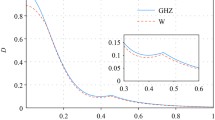Abstract
By using the works, Spiridonov (Phys Rev A 52:1909, 1995), and Wang et al. (J Phys A Math Gen 33:7451, 2000), we propose an approach to obtain genuine three-partite entangled coherent states in which the permutation symmetry and the parity one play crucial roles. We exploit the permutation and parity symmetry to construct entanglement in the standard coherent states of a system composed of three-mode bosonic field and three identical atoms. It is shown that by making use of entanglement witnesses (EW) based on GHZ-states the reduced density matrices of the three-mode bosonic field and three-atomic subsystems, after encoding as three-qubit systems, in some range of their respective parameters, are genuinely entangled.
Similar content being viewed by others
References
Horodecki R., Horodecki P., Horodecki M., Horodecki K.: Quantum entanglement. Rev. Mod. Phys. 81, 865 (2009)
Bennett C.H., Brassard G., Crepeau C., Jozsa R., Peres A., Wootters W.K.: Teleporting an unknown quantum state via dual classical and Einstein-Podolsky-Rosen channels. Phys. Rev. Lett. 70, 1895 (1993)
Ekert A.K.: Quantum cryptography based on Bells theorem. Phys. Rev. Lett. 67, 661 (1991)
Bennett C.H., Wiesner S.J.: Communication via one- and two-particle operators on Einstein-Podolsky-Rosen states. Phys. Rev. Lett. 69, 2881 (1992)
Nielsen M.A., Chuang I.L.: Quantum Computation and Quantum Information. Cambridge University Press, Cambridge (2000)
Yang Y., Xu J., Chen H., Zhu S.Y.: Long-lived entanglement between two distant atoms via left-handed materials. Phys. Rev. A 82, 030304 (2010)
Wang J., Pan Q., Jing J.: Projective measurements and generation of entangled Dirac particles in Schwarzschild spacetime. Ann. Phys. (NY) 325, 1190 (2010)
Pathak P.K., Hughes S.: Cavity-assisted fast generation of entangled photon pairs through the biexciton-exciton cascade. Phys. Rev. B 80, 155325 (2009)
Cho J., Angelakis D.G., Bose S.: Heralded generation of entanglement with coupled cavities. Phys. Rev. A 78, 022323 (2008)
Petitjean C., Jacquod P.: Lyapunov generation of entanglement and the correspondence principle. Phys. Rev. Lett. 97, 194103 (2006)
Yuan C.H., Ou Y.C., Zhang Z.M.: Generation of GHZ-type and W-type entangled coherent states of three-cavity fields. Chin. Phys. Lett. 23(7), 1695 (2006)
Hyunseok J., Nguyen B.A.: Greenberger-Horne-Zeilinger-type and W-type entangled coherent states: generation and Bell-type inequality tests without photon counting. Phys. Rev. A 74, 022104 (2006)
Yang M., Cao Z.-L.: Quantum information processing using coherent states in cavity QED. Phys. A 366, 243 (2006)
Nguyen B.A.: Optimal processing of quantum information via W-type entangled coherent states. Phys. Rev. A 69, 022315 (2004)
Nguyen B.A.: Cluster-type entangled coherent states: generation and application. Phys. Rev. A 80, 042316 (2009)
Yuan C.H., Ou Y.C., Zhang Z.M.: Generation of GHZ-type and W-type entangled coherent states of three-cavity fields. Chin. Phys. Lett. 23(7), 1695 (2006)
Wang X., Feng M., Sanders Barry C.: Multipartite entangled states in coupled quantum dots and cavity QED. Phys. Rev. A 67, 022302 (2003)
Solano E., Agarwal G.S., Walther H.: Strong-driving-assisted multipartite entanglement in cavity QED. Phys. Rev. Lett. 90, 027903 (2003)
Wang X., Sanders B.C.: Multipartite entangled coherent states. Phys. Rev. A 65, 012303 (2001)
Peres A.: Separability criterion for density matrices. Phys. Rev. Lett. 77, 1413 (1996)
Zyczkowski K., Horodecki P., Sanpera A., Lewenstein M.: Volume of the set of separable states. Phys. Rev. A 58, 883 (1998)
Vidal G., Werner R.F.: Computable measure of entanglement. Phys. Rev. A 65, 032314 (2002)
Wootters W.K.: Entanglement of formation of an arbitrary state of two qubits. Phys. Rev. Lett. 80, 2245 (1998)
Greenberger, D.M., Horne, M., Zeilinger, A.: In: Kafatos, M. (ed) Bell’s Theorem, Quantum Theory, and Conceptions of the Universe. Kluwer Academic, Dordrecht (1989)
Bouwmeester D., Ekert A., Zeilinger A.: The Physics of Quantum Information. Springer, Heidelberg (2000)
Horodecki M., Horodecki P., Horodecki R.: Separability of mixed states: necessary and sufficient conditions. Phys. Lett. A 223, 1 (1996)
Terhal B.M.: Bell inequalities and the separability criterion. Phys. Lett. A 271, 319 (2000)
Terhal B.M.: A family of indecomposable positive linear maps based on entangled quantum states. Linear Algebra Appl. 323, 61 (2000)
Jafarizadeh M.A., Behzadi N.: Entanglement via permutation symmetry and reflection invariance of angular momentum algebra. Eur. Phys. J. D 55, 729–744 (2009)
Jafarizadeh M.A., Behzadi N., Akbari Y.: Entanglement witnesses and characterizing entanglement properties of some PPT states. Eur. Phys. J. D 55, 197–203 (2009)
Acin A., Brus D., Lewenstein M., Sanpera A.: Classification of mixed three-qubit states. Phys. Rev. Lett. 87, 040401 (2001)
Bourennance M., Eibl M., Kurtsiefer C., Gaertner S., Weinfurter H., Guhne O., Hyllus P., Brus D., Lewensiein M., Sanpera A.: Experimental detection of multipartite entanglement using witness operators. Phys. Rev. Lett. 92, 087902 (2004)
Sivakumar S.: Entanglement of fields in coupled cavities: effects of pumping and fluctuations. Phys. Lett. A 374, 1793 (2010)
Guhne O., Hyllus P.: Investigating three qubit entanglement with local measurements. Int. J. Theor. Phys. 42(5), 1001 (2003)
Toth G., Guhne O.: Detecting genuine multipartite entanglement with two local measurements. Phys. Rev. Lett. 94, 060501 (2005)
Spiridonov V.: Universal superpositions of coherent states and self-similar potentials. Phys. Rev. A 52, 1909 (1995)
Wang X.G., Sanders B.C., Pan S.H.: Entangled coherent states for systems with SU(2) and SU(1,1) symmetries. J. Phys. A Math. Gen. 33, 7451 (2000)
Author information
Authors and Affiliations
Corresponding author
Rights and permissions
About this article
Cite this article
Behzadi, N. Genuine three-partite entanglement in coherent states via permutation and parity symmetries. Quantum Inf Process 12, 21–32 (2013). https://doi.org/10.1007/s11128-011-0352-9
Received:
Accepted:
Published:
Issue Date:
DOI: https://doi.org/10.1007/s11128-011-0352-9




